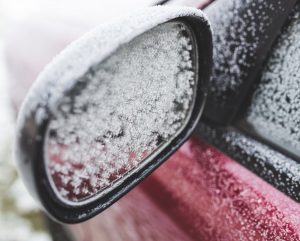 It is a Monday morning in the depths of a Michigan winter. You come out to your car and see it covered in snow. You grab your scrapper and feel the wind chill hit your exposed skin, and you find yourself pausing to think, “Can I get away with not clearing the snow off my car?” All Michiganders have found themselves pondering this question. And regardless of your mind trying to convince you that you could totally drive to work with just a small patch cleared from your windshield—Stroebel is here to say don’t do it.
It is a Monday morning in the depths of a Michigan winter. You come out to your car and see it covered in snow. You grab your scrapper and feel the wind chill hit your exposed skin, and you find yourself pausing to think, “Can I get away with not clearing the snow off my car?” All Michiganders have found themselves pondering this question. And regardless of your mind trying to convince you that you could totally drive to work with just a small patch cleared from your windshield—Stroebel is here to say don’t do it.
Not only is not cleaning the snow off your car endangering yourself and other drivers, but it is also, in fact, illegal in the state of Michigan. According to the Michigan Vehicle Code, drivers who do not clear their cars of both snow and ice can be subjected to sanction. The Michigan Vehicle Code has 3 important automobile snow removal codes that you need to be aware of before taking to the roads this winter.
In simple English, these 3 codes are:
- Remove the snow and ice from your vehicle before driving. Make sure that your visibility is good and that there is nothing on your vehicle that may reduce your ability to see the road and your environment.
- Make sure to clear off your tail lights, rear lamps, and Keep in mind if you can’t see your lights, then neither can other drivers.
- Make sure that there are no chunks of snow or ice on your vehicle, especially the hood and roof of your vehicle. If dislodged while driving these chunks of snow or ice can become hazardous if they fly off your vehicle, especially in the case of larger trucks and semis.
If you’d like to read the code itself, here you go:
- According to MICHIGAN VEHICLE CODE 257.709 section (1), subsection (c), “a person shall not operate a motor vehicle with an object that obstructs the vision of the driver of the vehicle, except as authorized by law.”
- In addition, MICHIGAN VEHICLE CODE 257.699 subsection (b) and (c) address tail lights, rear lamps and headlamps. Section (b) states, “there shall be an uppermost distribution of light or composite beam, so aimed and of an intensity, as to reveal persons and vehicles at a distance of at least 350 feet ahead for all conditions of loading. Section (c) further clarifies by asserting, “there shall be a lowermost distribution of light or composite beam, so aimed and of sufficient intensity to reveal persons and vehicles at a distance of at least 100 feet ahead; and under any condition of loading none of the high-intensity portions of the beam shall be directed to strike the eyes of an approaching driver.”
- Lastly, MICHIGAN VEHICLE CODE Section 257.677a covers the scary situation when a sheet of snow or ice suddenly falls from the roof of a nearby vehicle, sometimes hitting or nearly missing your vehicle or someone else’s car. According to section (3), “a person shall not deposit, or cause to be deposited, snow, ice, or slush onto or across a roadway or the shoulder of the roadway in a manner which obstructs the safety vision of the driver of a motor vehicle.” In addition, section (4) also states “a person shall not deposit, or cause to be deposited, snow, ice or slush on any roadway or highway.”
If you drive in the snow without adhering to these laws, not only are you putting yourself and others at risk, you could be pulled over and ticketed by law enforcement. So, as we approach another Michigan Winter, avoid a costly situation, and remove the snow and ice from your vehicle.
